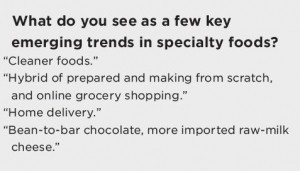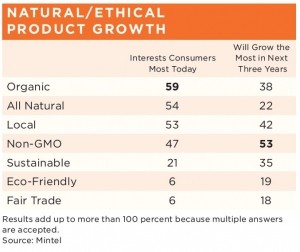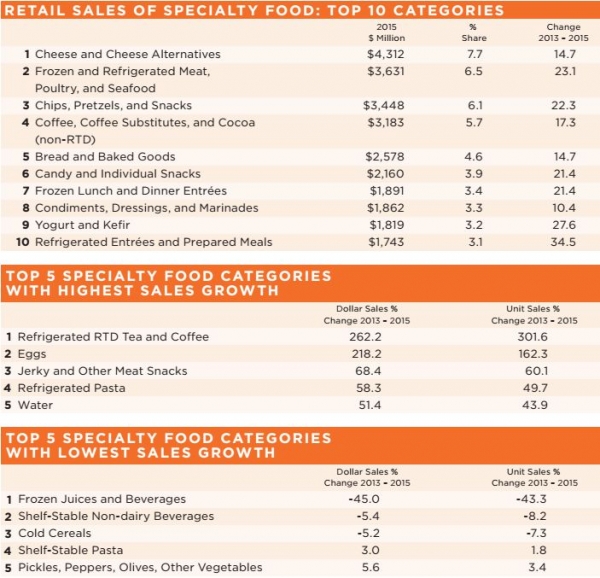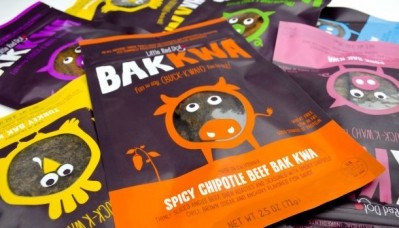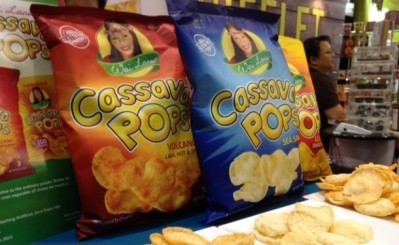US specialty food sales topped $120bn in 2015, now account for 14.1% of total food sales
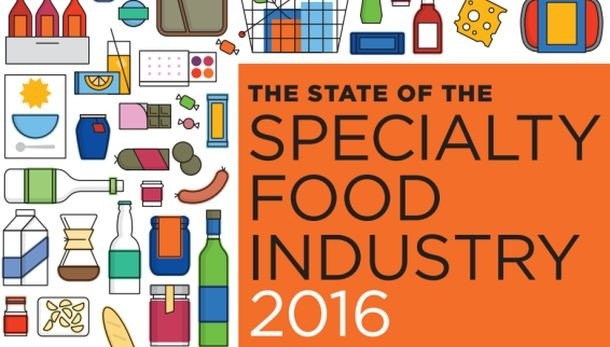
Total specialty food sales reached $120.5bn in 2015, a 21.2% increase over 2013, with retail sales up 19.7% to $94bn, driven by product innovations and increased distribution through mass-market outlets; and foodservice sales up 27% to $26.5bn over the same period.
However, e-commerce is also growing in importance as a route to market for specialty food, with 85% of manufacturers surveyed by Mintel for this report selling their wares via their own website and 49% using a third-party platform such as Amazon, says The State of the Specialty Food Industry 2016, which uses data from SPINS, IRI and Mintel.**
And while not all specialty food categories are on fire (eg. growth in specialty cold cereal and frozen juices is lagging that of conventional brands), notes the report, “Some categories are exploding in specialty versus their mainstream counterparts, especially refrigerated ready-to-drink tea and coffee.”
What's driving the growth?
Categories with the biggest sales growth in 2015 were refrigerated ready-to-drink tea and coffee; eggs; and jerky and other meat snacks, while categories with the highest penetration (50%+) of specialty goods were refrigerated meat alternatives, tofu, refrigerated salsas and dips, and tea; followed by refrigerated condiments, energy bars and gels, refrigerated pasta and pizza sauces, refrigerated pasta, and refrigerated non-dairy beverages (40%+).
"American consumers continue to move toward specialty foods and away from mass," said Ron Tanner, vice president of philanthropy, government and industry relations for the Specialty Food Association.
Here are some key takeaways:
SALES BY CHANNEL: Though mainstream retailers account for the largest share of specialty food sales (retailers such as Kroger, Costco, and Target account for more than four-fifths of sales), they are growing at an almost equal rate as specialty food and natural food stores.
FOODSERVICE VS RETAIL: Specialty food sales through foodservice are growing faster than retail sales.
FASTEST-GROWING:
Trends to watch in specialty retail
- "Home delivery..."
- "Micro-local, very small batch, changing inventory often..."
- "Large retailers mimicking small indies..."
Fifty-eight out of 61 specialty food categories enjoyed double-digit sales growth in 2015, and two grew by more than 200%. Fresh, protein, and convenience are three trends holding steady as evidenced in the specialty food categories showing the most sales growth: refrigerated RTD tea and coffee; eggs; jerky and other meat snacks; refrigerated pasta; and water.
NON-GMO: Many in the supply chain believe non-GMO will be a product claim of growing importance to consumers, with 49% of manufacturers planning to introduce non-GMO products in 2016.
CUISINE TO WATCH: According to specialty retailers surveyed by Mintel, Mediterranean, Middle Eastern, and Thai are the top three to watch.
*Specialty foods are defined as: "Foods or beverages of the highest grade, style, and/or quality in their respective categories. Their specialty nature derives from a combination of some or all of the following qualities: uniqueness, origin, processing method, design, limited supply, unusual application or use, extraordinary packaging, or channel of distribution/sales."
**SPINS provides three-year scanner data sales for food, drug, and mass segments and natural supermarkets (excluding Trader Joe’s, Walmart, and Whole Foods Market) for sales in 61 segments. To reach the U.S. sales total, Mintel added estimated sales of products that were not collected by scanner data. This includes PLU sales through all channels, including specialty food stores, as well as sales through Trader Joe’s and Whole Foods Market, but not Walmart.
Read more HERE.
